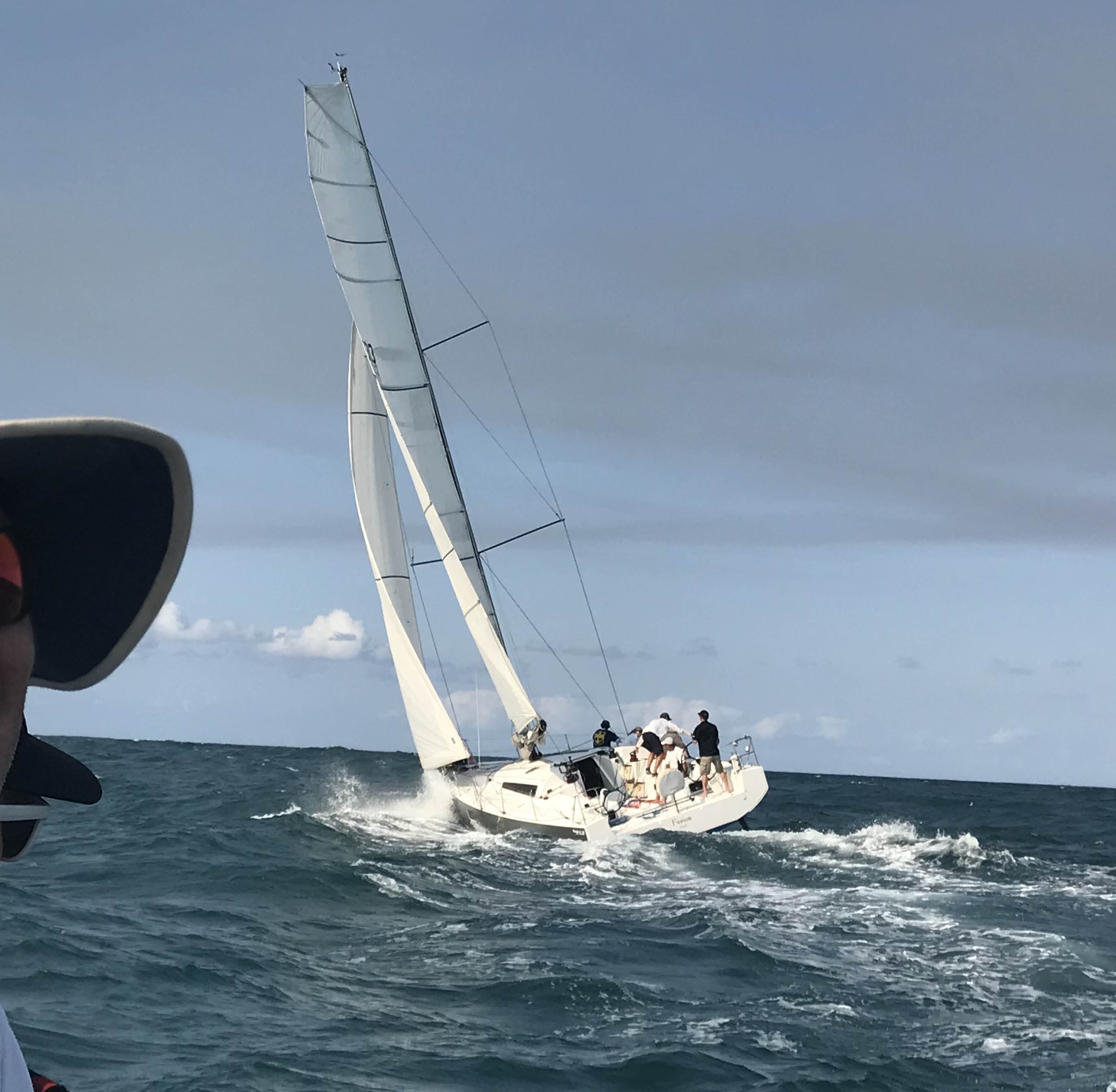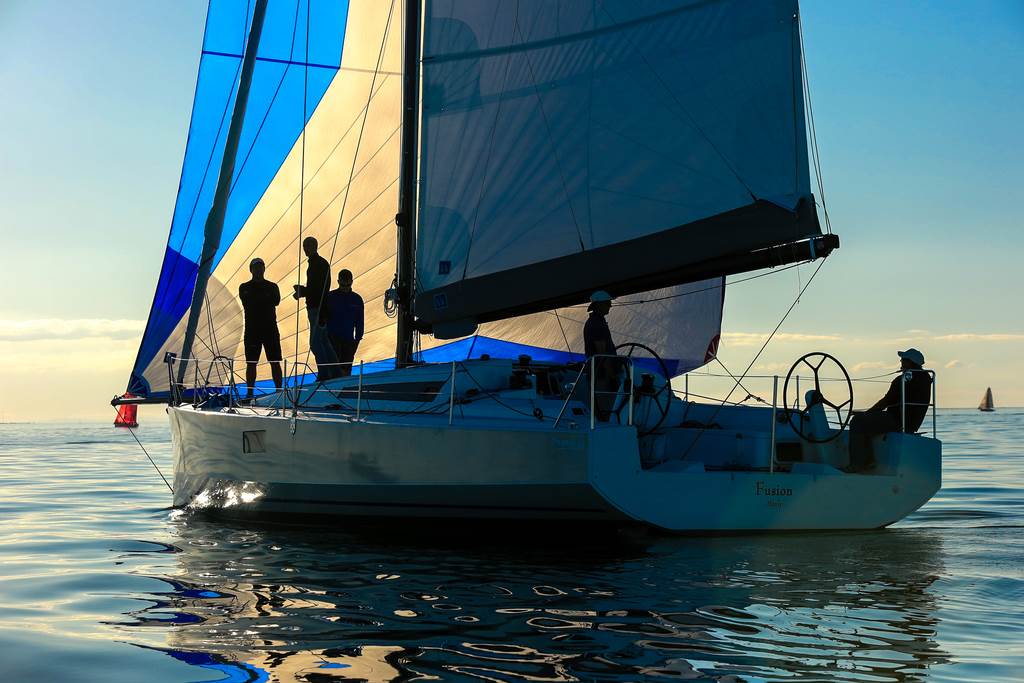Select to expand quote
2bish said..shaggybaxter said..2bish said..shaggybaxter said..How about we get some updated pics of everyone's pride and joy? Either sailing, parked up in an anchorage, on the dock/trailer, or even on the hard (it is winter after all) .
It can be either your own boat or the boat you sail on most regularly.
Post as little, or as much, detail as you like. I get a kick out of looking at all boats from dinghy's to cruisers, let alone gauging an idea of who has what. Lots of pics? Even better!
I'll kick it off...
Fusion is a Pogo 12.50, just celebrated her third birthday. This was taken heading offshore to the NW Fairways beacon off Caloundra. It was a close reach out to the mark, and we had the one ingredient needed to guarantee a happy Shaggy....wind. I'm the tubby one on the wheel.


Anybody got pics they're keen to share?
Nice twist in the main there Shaggy! the square top makes it easy to see. Doesn't the Pogo have a backstay? is it fractional rigged?
G'day 2bish,
As the traveller is so wide, it took me a while to work out that mainsheet/twist was still required. The slot on the Pogo is sooo important, it makes such a difference to pointing and speed. Once we're on course, we adjust the barber haulers and sheet position to match the jib with the main. A gun trimmer mate showed me how sets the slot by the bottom third of the sails. The top two thirds will be nicely matched if you get the lower third right.
No, no backstay, the spreaders are at 117 deg rake to offset the need. You need the rigidity of a cf mast though, that's why there is no alloy mast option on the 12.50. Its funny, everyone new on board goes to grab for the backstay at least once!
Yep, fractional rig, near 7/8. Has given me some grief trying to design a Code 0 for it, as the spreaders are so long and I can't use a masthead halyard. Sigh.
Pic showing the complete lack of runners/backstays to hold onto at the back of the boat!
Cheers SB.

Thanks Shaggy, that's really interesting. Must be hilarious waiting for people to grab the Phantom backstay. I'm still learning so it's always helpful hearing about real word experiences. So with no backstay and fractional rig, is there no need/facility to bend the mast to flatten the main further? Or is the main cut more like it would be on a masthead rig so it's naturally flatter to start with or something?
So I always trim my main first then headsail. It sounds like that's what you're saying, trim main, then trim the headsail and slot to suit the main, is that correct? What are you actually aiming for with the slot, are you watching the interaction of air onto the main? Or matching the shape?
cheers
B
Hi 2bish,
Firstly, apologies for the thread drift.
So with no backstay and fractional rig, is there no need/facility to bend the mast to flatten the main further?I always think control over mast bend is a good thing, so no, its more a compromise than a feature. To offset this, it uses a carbon fibre mast which is much more resistant to mast bend over a similar alloy mast. The mast will still bend, ie it bends forrard at the top running downwind in big airs with a big kite up. A backstay would be handy then for example.
Or is the main cut more like it would be on a masthead rig so it's naturally flatter to start with or something
Yes, the main is pretty flat, as even dw its really only reaching most of the time due to apparent wind. The stiffness of the mast is taken into account when determining the cut of the sail, so the rig is a factor on sail shape definitely.
So I always trim my main first then headsail. It sounds like that's what you're saying, trim main, then trim the headsail and slot ..
Yep. If I'm short handed, I always trim my main first then headsail to suit. If I'm fully crewed it happens pretty much at the same time of course.
The headsail sheet is always eased slightly after a tack anyway, as sheeting it hard on straight after the tack will just kill your acceleration. So, I first set traveller for optimal wind angle, then mainsheet for amount of twist, then sheet on the headsail the last few inches to get inner telltales flying up at an angle, then I start adjusting clew position and readjust jibsheet to suit by looking at the slot.
I've noticed at first I was often oversheeting and killing the air through the slot even though the headsail telltales were flying merrily. I run a full battened main, a negative of which is that backwinding isn't as noticeable.
Then repeat the process as a fine trim, as the headsail trim will have effected your main trim etc etc. When I can let go of the helm and the boat tracks straight regardless of the angle, I know I've got it trimmed right. A bad slot and it simply won't ever stay straight, and it appears sluggish both in the feel and the speed.
Are you watching the interaction of air onto the main? Or matching the shape?Shape. I'm looking at the leaches on both sails, ie: I'm trying to match the trailing edges. Car too far back, and the headsail leach falls away from the main as you look up. Car too far forward, and the headsail leach comes inward to the main as you look up. Just focus on the bottom third, get that right and the top two thirds will be fine.
Lydia taught me a neat trick, and that was after trimming the boat, steer not off your telltales but a course that maintains a constant angle of heel, (whatever the nominal heel angle may be for your boat). This makes the amount of rudder input minimal (no dragging of rudders), much less fatigue for the driver, much less leeway and much better average speeds.
Cheers,
SB



























![]() Only room for essentials
Only room for essentials ![]()



















